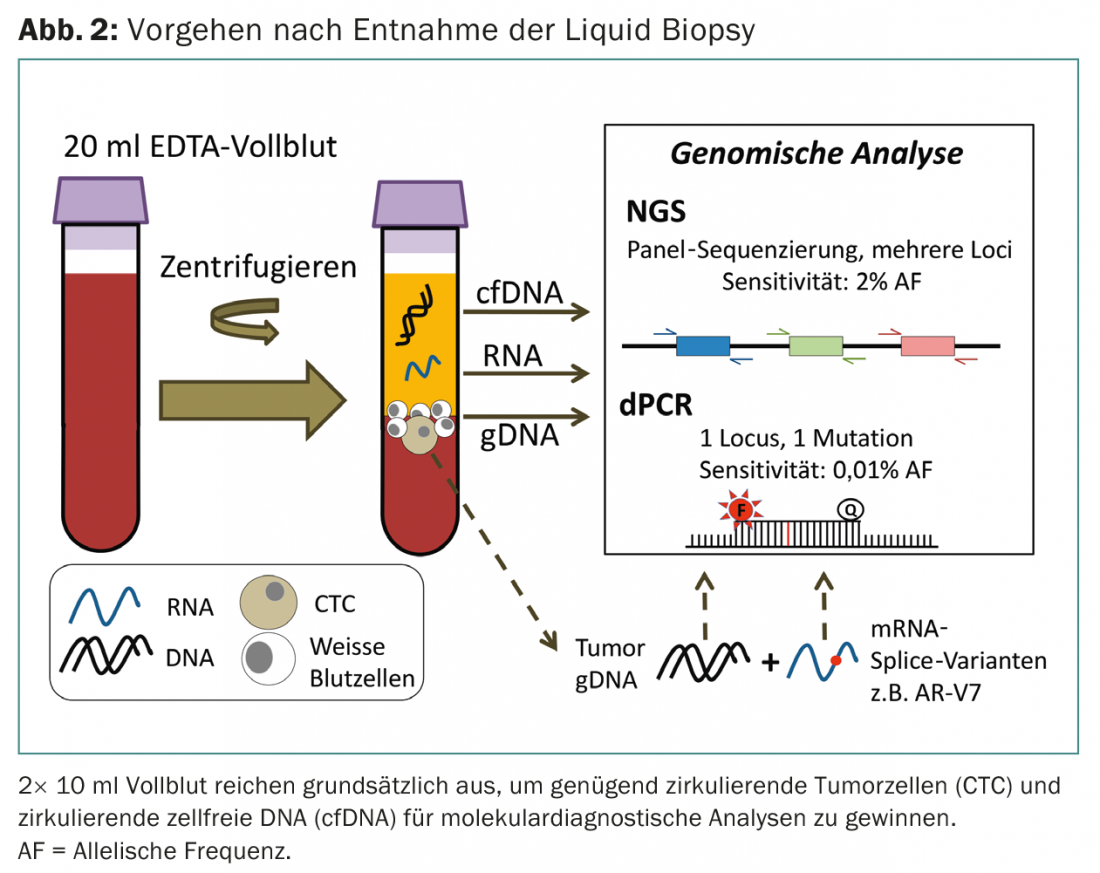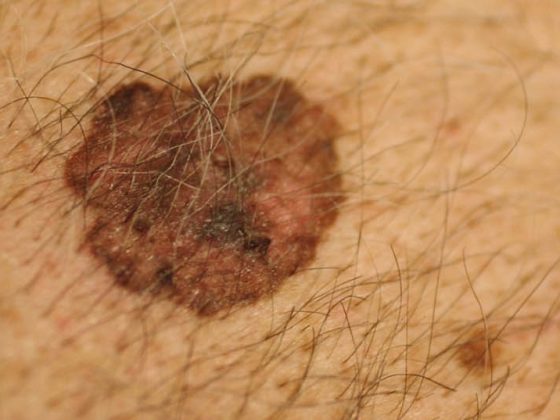In tumor diagnostics, the term liquid biopsies refers to the analysis of circulating cell-free DNA (cfDNA) and circulating tumor cells. Nowadays, it is possible to detect the mutations of a tumor in advanced tumors in a minimally invasive way by means of cfDNA analyses. Plasma, not serum, should be used for cfDNA testing. Circulating tumor cells will be able to be used for predictive marker analysis in the near future, such as for the determination of AR-V7 splicing variant in castration-resistant prostate cancer.
Although the term liquid biopsies is relatively new in the context of molecular tumor diagnostics, it has become widely accepted by pathologists and oncologists. In tumor diagnostics, this term was first used for the analysis of circulating tumor cells (“CTC”) and only later for that of circulating cell free DNA (“cfDNA”). In summary, this is a generic term for the removal of material from a solid tumor by simply drawing a blood sample. Nevertheless, the term “liquid biopsy” is not limited exclusively to its use in tumor diagnostics: In prenatal diagnostics, blood samples can be used to draw conclusions about chromosomal abnormalities in the fetus.
Interest in minimally invasive detection
Circulating tumor cells (CTC) and circulating cell-free DNA (cfDNA) have been studied for decades and discussed as potential diagnostic and prognostic markers in the literature. The first description of CTC took place in the 19th century by the Australian J. Ashworth (1869), that of cfDNA a little less than a century later by the two Frenchmen P. Mandel and P. Metais (1948).
CTC can originate from both the primary tumor and metastases. It is not yet clear whether the release of CTC is an active process and thus part of a biological program of a tumor, or whether the release is random. However, it is known that some of these cells have the ability to survive in the bloodstream and proliferate elsewhere in the human body. to form a metastasis. There is controversy as to whether single cells are sufficient for this purpose or whether associations (clusters) of tumor cells are not responsible for the process of hematogenous distant metastasis [1].
In contrast, circulating cell-free DNA (cfDNA) originates from dying (apoptotic or necrotic) cells. The cfDNA consists of DNA from both tumor cells (circulating cell-free tumor DNA, abbreviated ctDNA) and healthy cells (circulating cell-free normal DNA, abbreviated cnDNA). It is controversial whether cfDNA exerts any function in the blood. Compared to CTC (1-2.5 hours), cfDNA has a relatively short half-life of 15-30 minutes.
Both CTC and cfDNA/ctDNA are strongly gaining importance for tumor diagnostics thanks to the new possibilities for genomic testing. Next Generation Sequencing (NGS) nowadays allows the sequencing of whole genomes within a very short time. Since the use of this technology in a large number of clinical trials, the number of potentially predictive genomic markers has greatly increased and, consequently, the interest in minimally invasive detection of these predictive markers in blood.
Determine mutations significantly
Compared to conventional Sanger sequencing, NGS allows larger regions to be sequenced simultaneously and especially with a high depth (redundancy). This depth is necessary when detecting subclonal mutations or when tumor DNA represents only a fraction of the total DNA to be analyzed. The latter is the case with the analysis of ctDNA: Depending on the tumor entity and the stage of the tumor disease, the ctDNA content in the blood can vary greatly or be as low as a few parts per thousand.
With most NGS sequencers, standard protocols can detect mutations that account for only 2-5% of total DNA. However, especially in not yet advanced tumors or in patients under therapy, the ctDNA is often below this threshold. In contrast to NGS, digital PCR allows the determination of a mutation in this highly sensitive range: with the help of specific fluorescence-labeled probes, certain mutations can be significantly determined in the range of 0.01%. The procedure and technique are described using the example of digital droplet PCR (Fig. 1) . The disadvantage of this method is that a separate reaction must be performed for each mutation to be determined. Therefore, it is not recommended to use this methodology for a general study of the genome, but only for the study of single mutations.

Circulating tumor cells (CTC)
In the last decade, there have been a large number of studies showing that the detection of a greater amount of CTC in the blood of patients with advanced cancer is associated with poor survival [2]. In this context, the U.S. Food and Drug Administration (FDA) has approved the collection of the number of CTC for the assessment of prognosis in patients with metastatic prostate, colorectal and breast cancer using the CellSearch® (Veridex) device. This is the only FDA-approved device for the determination of CTC.
The detection or enrichment of circulating tumor cells remains a technological challenge: In 10 ml of whole blood there are approximately 50 billion red blood cells, 50 million white blood cells, but only between 0 and 100 CTC. Basically, there are two technical methods to detect and record CTC in blood. One can use for this purpose an approach based on the biological properties of the CTC, in particular on the expression of proteins that are present only in the CTC but not in the blood cells. Thus, CTC can be captured with antibodies against epithelial cell-specific proteins such as EpCAM or cytokeratins. Another way is to recognize the CTC based on their different physical properties such as density, size or deformability.
Predictive CTC tumor diagnostics for the future.
In the past, clinical trials focused on the number of CTC and correlation with survival. Due to technological advances, it is now possible to fish out these cells and analyze them using NGS or other technologies, such as real-time PCR [3]. Although this approach is currently mainly used in research, there are legitimate hopes that predictive tumor diagnostics can be performed on these cells in the future.
To date, the most promising example of predictive use of CTC is the determination of AR-V7 status in patients with castration-resistant prostate cancer. AR-V7 is a splicing variant of the androgen receptor gene that results in an altered protein that is constitutively active. Antonarakis et al. were able to show that patients whose CTC expressed AR-V7 RNA had a poorer response to enzalutamide and abiraterone therapies [4]. The assay used in this study is based on capturing CTC using antibodies and performing real-time PCR with specific AR-V7 primers on the extracted mRNA. This CTC-based AR-V7 test will be commercialized in the near future. It could be considered a milestone for the use of CTC to detect mutations, gene fusions and other predictive markers.
Circulating cell-free DNA (cfDNA)
While the first cfDNA studies investigated a possible correlation of cfDNA quantity with prognosis, nowadays NGS can be used to determine the base sequence of cfDNA (i.e., ctDNA) originating from tumor cells. Since the differentiation between general cfDNA and ctDNA is not possible during the extraction of cfDNA for technical reasons, the majority of cfDNA may consist of cnDNA and not ctDNA. Nevertheless, in order to determine the mutations in the ctDNA, a high depth must be achieved in NGS. Blood plasma is required for cfDNA testing.
Using NGS, tumor ctDNA mutations have recently been detected in up to 75% of patients with advanced tumors [5]. In non-advanced tumors, the detection rate decreases to approximately 50%. However, these rates are expected to increase with the use of more sensitive methods.
Several studies have shown that the amount of ctDNA correlates with tumor burden: if the tumor responds to therapy, the amount of ctDNA in the patient’s blood decreases. The opposite is true for the occurrence of a recurrence: In a small collective of breast cancer patients, Dawson et al. show an increase in blood ctDNA levels weeks before standard imaging could detect the recurrence [6]. For these investigations, it is sufficient to determine or quantify a few mutations in the blood specific to the tumor in question. If liquid biopsy is used to investigate whether a patient’s tumor has a predictive mutation, so-called panels, which vary greatly in size, are usually used for sequencing (Fig. 2).

The standard panels used in tumor diagnostics cover mutations between 20 and 50 genes. These genes are therapy-relevant genes such as EGFR, KRAS, NRAS or BRAF. As mentioned, because high sequencing depths are required for cfDNA sequencing, sequencing resources and costs increase with the size of the panel.
Due to the high clinical relevance of the applications, cfDNA-based examinations are now already very close to clinical routine: The pathology department of the University Hospital Basel has been offering cfDNA analysis for diagnostics since April of this year. Here, NGS panels or digital PCR are used to screen patients’ cfDNA for mutations with predictive properties. This is of particular interest if a tissue biopsy is not possible or not reasonable in a patient. This application is currently being introduced mainly in the predictive diagnosis of lung cancer. However, an expansion to other tumor entities is foreseeable.
Using cfDNA studies, the known and therapy-relevant EGFR mutations can be determined in a non-invasive manner, including in particular the EGFR T790M mutation, which is predictive of response to osimertinib in patients with resistance to EGFR tyrosine kinase inhibitors (EGFR-TKIs).
A case from practice
In a patient with TTF1-positive, stage IV adenocarcinoma of the lung, a mutation in the EGFR gene was detected three years ago by sequencing tumor cells from bronchoalveolar lavage (p.E746-T751delinsF). The patient was then treated with the EGFR TKI erlotinib for eight months and subsequently, as second-line therapy, with afatinib (Fig. 3).

Sequencing of a tissue biopsy revealed a KRAS mutation (p.G13D) suggestive of resistance to EGFR-TKIs. The patient was switched to short-term chemotherapy due to severe side effects of EGFR TKIs, followed by treatment with the PD 1 inhibitor nivolumab. Imaging showed tumor progression at this time. Due to the inaccessibility of the tumor, a liquid biopsy was performed: In addition to the original EGFR mutation, a TP53 mutation and an EGFR T790M mutation were newly detected. The latter is predictive of response to osimertinib. The patient was treated with osimertinib and showed a partial response on computed tomography two months after initiation of therapy.
Literature:
- Cheung KJ, et al: A collective route to metastasis: seeding by tumor cell clusters. Science 2016 Apr 8; 352(6282): 167-169.
- De Bono JS, et al: Circulating tumor cells predict survival benefit from treatment in metastatic castration-resistant prostate cancer. Clin Cancer Res 2008 Oct 1; 14(19): 6302-6309.
- Lohr JG, et al: Whole-exome sequencing of circulating tumor cells provides a window into metastatic prostate cancer. Nat Biotechnol 2014 May; 32(5): 479-484.
- Antonarakis ES, et al: AR-V7 and resistance to enzalutamide and abiraterone in prostate cancer. N Engl J Med 2014 Sep 11; 371(11): 1028-1038.
- Bettegowda C, et al: Detection of circulating tumor DNA in early- and late-stage human malignancies. Sci Transl Med 2014 Feb 19; 6(224): 224ra24.
- Dawson SJ, et al: Analysis of circulating tumor DNA to monitor metastatic breast cancer. N Engl J Med 2013 Mar 28; 368(13): 1199-1209.
InFo ONCOLOGY & HEMATOLOGY 2016; 4(4): 10-13.











